Are you tired of the same old shoulder exercises that only work the front and side of your shoulders? It’s time to switch things up and target the often-neglected rear deltoids with the rear delt row.
Rear Delt row is a very effective and functional exercise for building muscle and strength in the rear deltoids and upper back.
There are many ways to do the rear delt row, and you can do it with dumbbells, a barbell, or a cable machine.
This article will answer all of your questions and explain everything you need to know.
- What is the rear delt row
- Muscles worked doing rear delt rows?
- Its benefits
- Rear delt row variation
- It’s alternatives or substitutes.
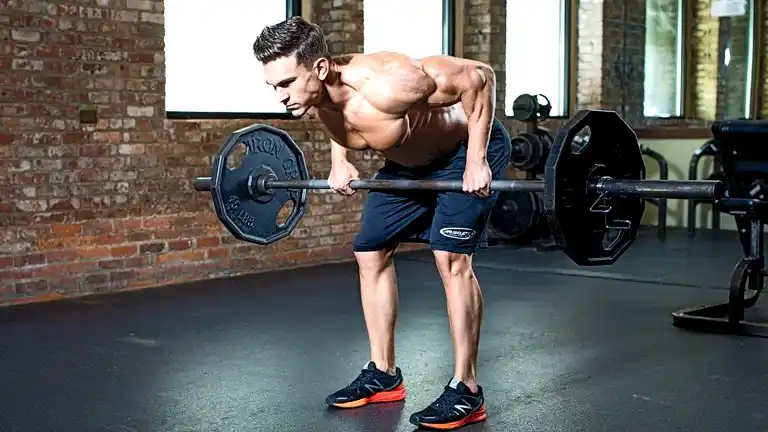
- What is Rear Delt Row?
- Rear Delt Row Muscles Worked
- 1. Dumbbell Rear Delt Row
- How To Do It
- Tips and Form
- 2. Chest Supported Dumbbell Rear Delt Row
- How To Do It
- Tips and Form
- 3. Bent Over Rear Barbell Delt Row
- How To Do It
- Tips and Form
- 4. Chest-Supported Barbell Rear Delt Row
- How To Do It
- Tips and Form
- 5. Seated Cable Rear Delt Row
- How To Do It
- Tips and Form
- 6. Cable Machine Rear Delt Row
- How To Do It
- Tips and Form
- 7. Kneeling High Cable Delt Row
- How To Do It
- Tips and Form
- 8. Chest Supported Delt Cable Row
- How To Do It
- Benefits of Rear Delt Row
- Best Alternatives for Rear Delt Row
- Frequently Asked Question
- Do Rows Work Rear Delts
- Are rear delt rows effective?
- What equipment do I need for Rear Delt Rows?
- What muscles do Rear Delt Rows work?
- How many sets and reps should I do for Rear Delt Rows?
- Can beginners perform Rear Delt Rows?
- Are Rear Delt Rows an effective exercise for building shoulder mass?
- Takeaways
What is Rear Delt Row?
The rear delt row is a compound exercise that targets the rear deltoids and upper body, including the rhomboids, trapezius, and rear deltoids.
Imagine you are pulling a weight towards your torso while keeping your elbows flared out to the sides. At the top of the movement, focus on squeezing your shoulder blades together for maximum rear delt activation.
The beauty of the rear delt row lies in its adaptability. Whether you’re a gym veteran or a home workout enthusiast, there’s a version for you:
- Dumbbells Rear Delt Row: Offer excellent range of motion and unilateral focus (working one side at a time).
- Barbell Rear Delt Row: This allows you to lift heavier weights, boosting overall strength.
- Cable Rear Delt Row: Provide constant tension throughout the entire movement.
- Machine Delt Row: Beginner-friendly option.
Rear Delt Row Muscles Worked
The rear delt row is a compound exercise that works many muscles simultaneously.
The main muscles worked during the barbell rear delt row are:
Secondary muscles worked during the rows:
- Latissimus dorsi,
- Biceps, brachialis
- Brachioradialis
- Infraspinatus
The muscles in the legs can be used as either dynamic stabilizers or static stabilizers.
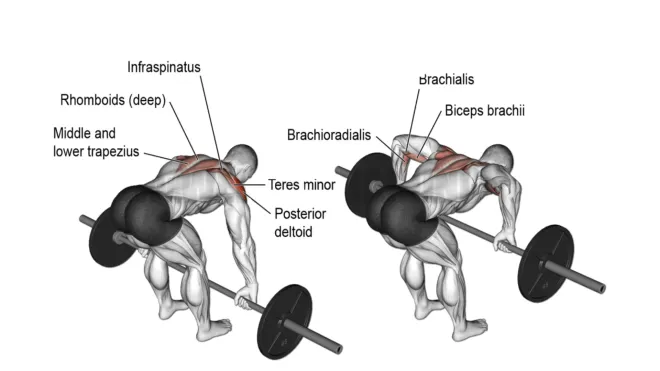
1. Dumbbell Rear Delt Row
The rear deltoid dumbbell row exercise is simple and effective. It is used to target your lats and rear deltoids.
This exercise is similar to a basic one-arm dumbbell row for the lats, except for some important modifications.
It isolates and strengthens the rear deltoids better than other shoulder exercises like shoulder presses or lateral raises.
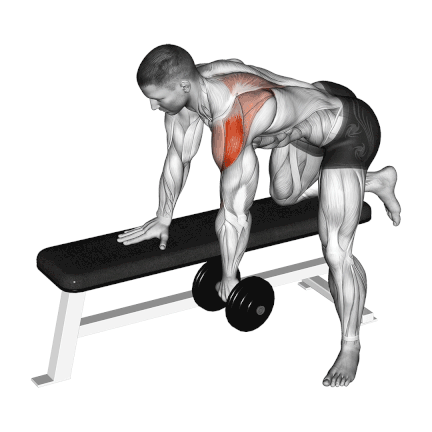
How To Do It
- Place one knee and hand on a bench for support.
- Your back should be flat and parallel to the floor.
- Hold a dumbbell in the opposite hand, palm facing towards your body.
- Pull the dumbbell towards your lower rib area, flaring your elbow to the side.
- Squeeze your shoulder blade at the top of the movement.
- Slowly lower the dumbbell back to its starting position.
- While keeping your back flat, pick up a dumbbell in your right hand.
- Switch sides and repeat.
Tips and Form
- Keep a controlled motion and avoid jerky movements.
- Always use weights that you can comfortably handle.
2. Chest Supported Dumbbell Rear Delt Row
The chest-supported dumbbell rear delt row is a variation that offers enhanced stability and rear delt isolation compared to the standard version.
The support also minimizes strain on your lower back.

How To Do It
- Set an incline bench to a 30-45 degree angle.
- Lie face-down on the bench, chest supported, with dumbbells in each hand and palms facing each other.
- Keep your body stable and pull the weights towards your hips.
- Flare your elbows out and up as you lift, leading the movement with your elbows.
- Squeeze your shoulder blades at the peak of the motion.
- Slowly return the dumbbells to their initial position.
Tips and Form
- If a higher incline proves uncomfortable, lower the angle slightly.
- Keep a controlled motion and avoid jerky movements.
Know More: 15 Best Delt Exercises For Complete Shoulder Development
3. Bent Over Rear Barbell Delt Row
Standing barbell rear delts row is a free weight exercise that primarily targets the rear deltoid and middle back, and to a lesser degree, it also targets the biceps and traps.
If you haven’t tried this exercise before, load the barbell with a reasonable amount of weight, prioritizing an amount that allows you to stick to proper form rather than trying to lift heavy.

How To Do It
- Stand with your feet shoulder-width apart and your knees slightly bent.
- Bend forward at the hips, keeping your back straight and your head up.
- Grasp the barbell with an overhand grip, hands shoulder-width apart.
- Pull the barbell up towards your upper chest, keeping your elbows flared out and away from your body.
- Squeeze your rear deltoids as you pull the barbell up.
- Slowly lower the barbell back down to the starting position.
Tips and Form
- Refrain from using your biceps to do the work. Focus on targeting the rear delts, and the arms should only act as hooks.
- Maintaining the right posture while working out is vital.
4. Chest-Supported Barbell Rear Delt Row
A chest-supported dumbbell row is an effective variation. As the name suggests, it’s a row where your chest is supported.
This variation is especially useful for individuals with lower back issues or who want to minimize other muscle groups’ involvement during the exercise.

How To Do It
- Set an incline bench to a 30-45 degree angle.
- Lie face-down on the bench with a barbell on the floor beneath your chest.
- Grasp the barbell with an overhand grip, slightly wider than shoulder width.
- Slowly pull the barbell until your elbows are just above your shoulders.
- Squeeze your shoulder blades at the top.
- Return to the starting position and repeat for as many reps and sets as desired.
Tips and Form
- At the bottom of the movement, don’t rest the barbell on the floor
- Don’t just swing your arms. Keep controlled motion throughout the exercise.
Know More: 25 Best Rear Delt Exercises For Mass And Strength
5. Seated Cable Rear Delt Row
The cable rear delt row will become more of a standard wide-grip cable row.
This variation provides a constant tension throughout the movement, helping to isolate and strengthen the rear deltoids effectively.

How To Do It
- Grab the long bar with an elbow-width grip.
- Ensure your torso is upright, your back is straight, and your arms and shoulders are fully extended in front of you.
- Pull the bar towards your upper chest while keeping your arms straight up and your body still.
- Keep your elbows at shoulder height and keep your body still.
- Slowly return the bar to the starting position.
- Try 3–4 sets of 10-15 repetitions.
Tips and Form
- Avoid shrugging your shoulders.
- Focus on the form before you go for a heavyweight.
6. Cable Machine Rear Delt Row
The standing cable rear delt row with rope is a very effective and functional exercise for building muscle and strength in the rear deltoids and middle trap.
It is usually performed for moderate to high reps, at least 8–12 reps per set, as part of an upper-body or shoulder-focused workout.
Using cables keeps tension on the rear delts, which is very beneficial for maximizing muscle hypertrophy.
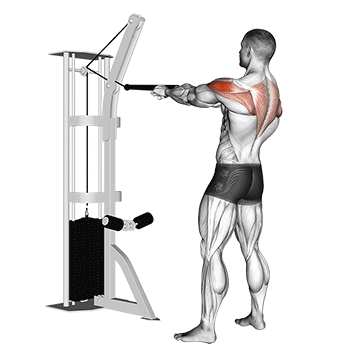
How To Do It
- Attach a double-grip rope to a cable pulley about mid-chest level.
- Grasp one end of the rope in each hand and step backward until the rope is pulled taut and your arms and shoulders are stretched forward.
- Keep your lower back upright and slide your hips back so that your knees are slightly bent.
- Keeping your elbows out to the sides, exhale as you pull the rope towards your shoulders until your elbows travel past your back.
- Slowly return the rope to the starting position.
Tips and Form
- Retract your shoulder blades to keep your rear delts engaged during the exercise.
- Pull the rope outward during the positive portion of the rep, so your elbows are flared out, which will really stimulate the rear deltoids.
- Maintaining the right posture while working out is essential.
7. Kneeling High Cable Delt Row
Half kneeling high cable row rope is a tremendous exercise that effectively works many muscles, including the shoulder, back, wing, and trapezius muscles.
This exercise provides people with shoulder issues with an exercise to benefit from rows.
Besides that, it is one of the most effective corrective exercises that help compensate for poor posture and shoulder dysfunction.
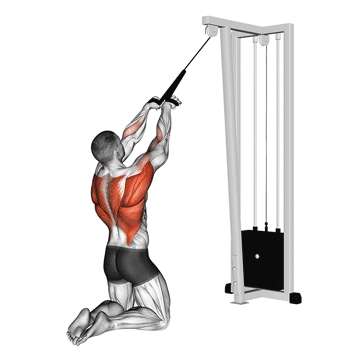
How To Do It
- Set the cable up at a high point with the rope attachments
- Grab the rope with both hands using an overhand grip.
- Step back and kneel in front of the cable machine.
- Starting with your arms stretched out and away, pull back through your elbows until your hands are just in front of your shoulders
- Slowly return to the starting position.
Tips and Form
- Don’t lean backwards to pull the weight towards you.
- Focus on the mind-muscle connection to pull down by using your back muscles.
8. Chest Supported Delt Cable Row
The chest-supported cable delt row is performed on a weighted horizontal cable machine with a bench.
It is an excellent compound exercise for developing the middle and upper back, and it offers useful arm work.
The chest-supported row can be performed with different grip positions and using different angles and attachments.
- Underhand grip
- Single-arm high row
- Rope attachment,
- Long bar
- Double arm low row….. Get creative!
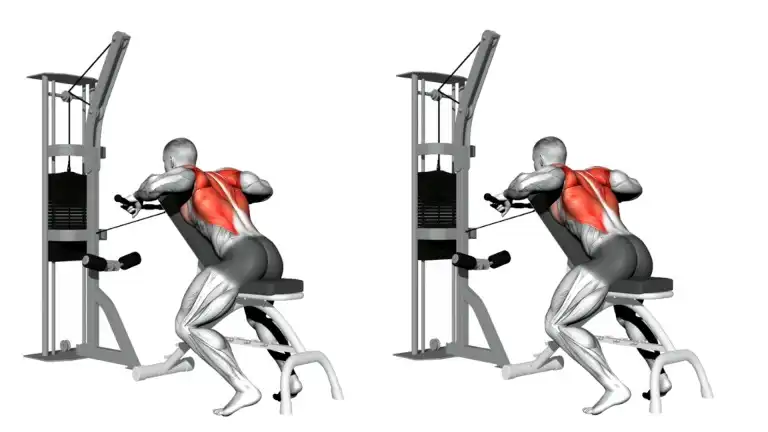
How To Do It
- Attach a rope handle to a cable setup.
- Adjust an incline bench to between 30–45 degrees and place it in front of the cable machine.
- Sit on the bench with your chest against the backrest. Grip the handles and extend your arms.
- Pull your shoulders down and back and brace your core.
- Bend your arms and pull the handles in toward your lower ribs.
- Lead with your elbows, keep your wrists straight, and squeeze your shoulders together.
- Smoothly extend your arms, let your shoulders shrug forward to stretch your upper back, retract your shoulders again, and repeat.
Know More: Guide To Mastering The Cable Row: Benefits, Form, Variations
Benefits of Rear Delt Row
Listed below are the benefits of performing the delt row exercise.
- It helps you work many muscles that directly affect your posture.
- It recruits the postural and stabilizer muscles important for shoulder stability.
- It promotes aesthetically and functionally balanced shoulders.
- Build symmetry with the shoulder, preventing a “forward-sloping” look.
- It’s a versatile exercise that adds variety to your workout routine.
- Improves athletic performance.
- Increases overall shoulder strength and muscle definition.
Best Alternatives for Rear Delt Row
Working your delts can be done by various exercises; we will mention a very popular alternative exercise – that you can do alongside or instead of the regular rear delt row.
Before we explore the best rear delt row alternatives. We must remember, a good delt row alternative will be able to satisfy the following criteria:
- Activate the rear muscle groups trained in the rear delt row.
- Isolate the muscle groups during execution.
- Train the rear delt muscle through a longer range of motion
These alternatives might work better for you.
- Face Pull
- Renegade Row
- Seated Rear Delt Fly
- Machine Rear Delt Fly
- Rear Delt Cable Fly
- Landmine Row
- Upright Row
Frequently Asked Question
Do Rows Work Rear Delts
Yes, rows do work rear delts, but the degree of their involvement depends on a few factors, such as row type, form and Grip.
- Wide Grip: Generally, a wider grip will work your rear delts and traps more than a narrower grip.
- Elbow Path: Keep your elbows flared out during the row to actively target those rear delts.
- Traditional Bent-Over Rows (Barbell or Dumbbell): These hit the rear delts significantly, along with other upper back muscles like your lats, rhomboids, and traps.
- Chest-Supported Rows: Offer more specific rear delt isolation since they minimize torso and lower back involvement.
Are rear delt rows effective?
Whether you are doing rear delt rows with dumbbells, barbells, or cables, all are very effective for training your upper back and shoulder muscles. It especially works your rear delts, which are small muscles on the back of your shoulders.
What equipment do I need for Rear Delt Rows?
Rear delt rows can be performed with dumbbells, barbells, cables, or resistance bands.
What muscles do Rear Delt Rows work?
Rear delt rows primarily work the rear deltoid muscles.
However, they also work other muscles, such as the middle trapezius, rhomboids, and rotator cuff muscles.
How many sets and reps should I do for Rear Delt Rows?
Aim for 3–4 sets of 8–12 reps per set. You can also adjust the weight and reps to challenge yourself.
Can beginners perform Rear Delt Rows?
Yes, beginners can perform rear delt rows, but it’s important to start with a lighter weight and focus on proper form.
Are Rear Delt Rows an effective exercise for building shoulder mass?
Yes, Rear Delt Rows are an effective exercise for building shoulder mass, particularly in the rear deltoid muscles.
Takeaways
Now that you know a few variations for your rear delts row, hit the gym and try each one to get the full effect. Don’t limit yourself to variations on this exercise, either.
Seek new and interesting ways to perform all your staple movements so that you never get stuck waiting at the gym, never grow bored, and always keep growing.
References
- Campos YAC, Vianna JM, Guimarães MP, et al. Different Shoulder Exercises Affect the Activation of Deltoid Portions in Resistance-Trained Individuals. J Hum Kinet. 2020;75:5-14. Published 2020 Oct 31. doi:10.2478/hukin-2020-0033
- Ronai, Peter MS, CSCS, RCEP: Exercise Modifications and Strategies to Enhance Shoulder Function. Strength and Conditioning Journal: August 2005 – Volume 27 – Issue 4 – p 36-45
- Botton C, Wilhelm E, Ughini C, Pinto R, Lima C. Electromyographical analysis of the deltoid between different strength training exercises. Med Sport. 2013;17:67–71
- Franke AR, Botton C, Rodrigues R, Pinto R, Lima C. Analysis of anterior, middle and posterior deltoid activation during single and multijoint exercises. J Sports Med Phys Fitness. 2015;55:714–721.

Manish brings over 10 years of hands-on experience in weight lifting and fat loss to fitness coaching. He specializes in gym-based training and has a lot of knowledge about exercise, lifting technique, biomechanics, and more.
Through “Fit Life Regime,” he generously shares the insights he’s gained over a decade in the field. His goal is to equip others with the knowledge to start their own fitness journey.
